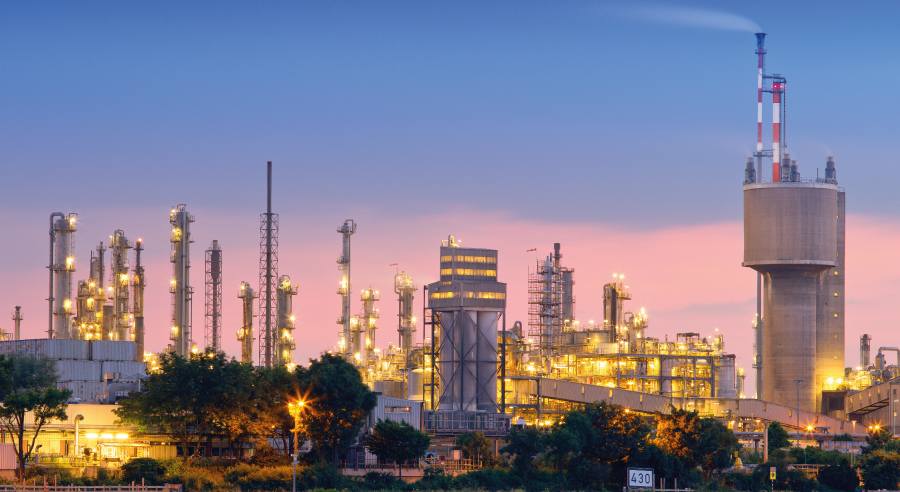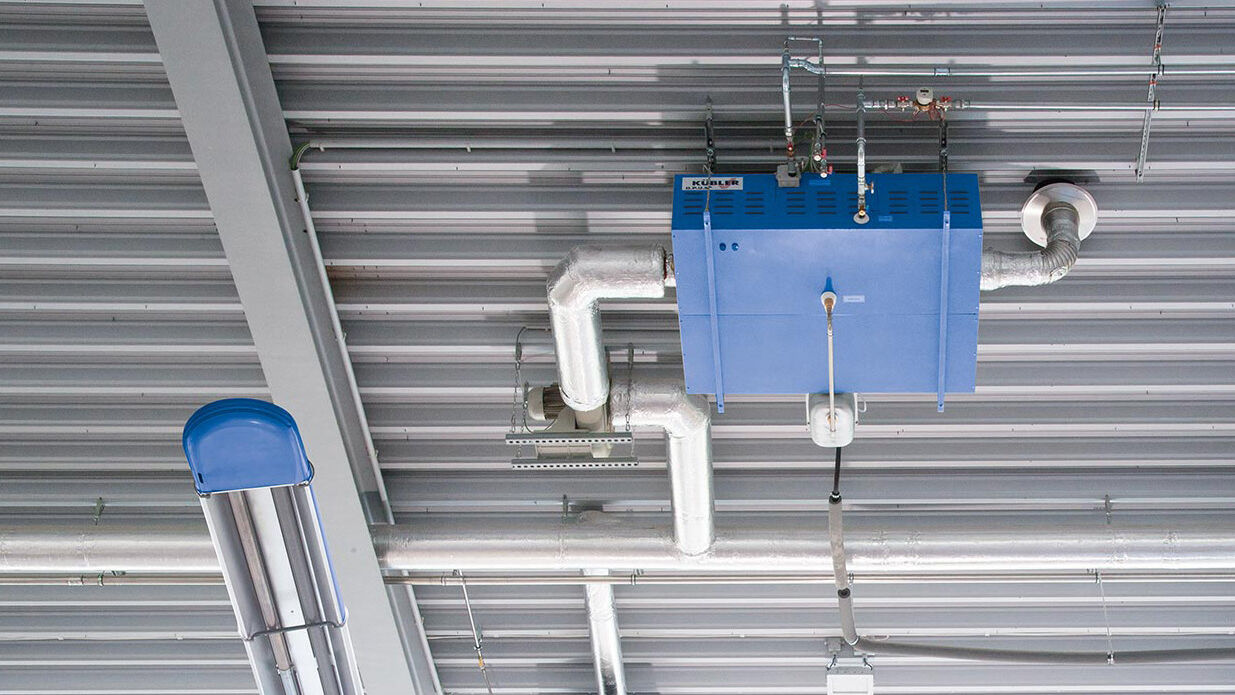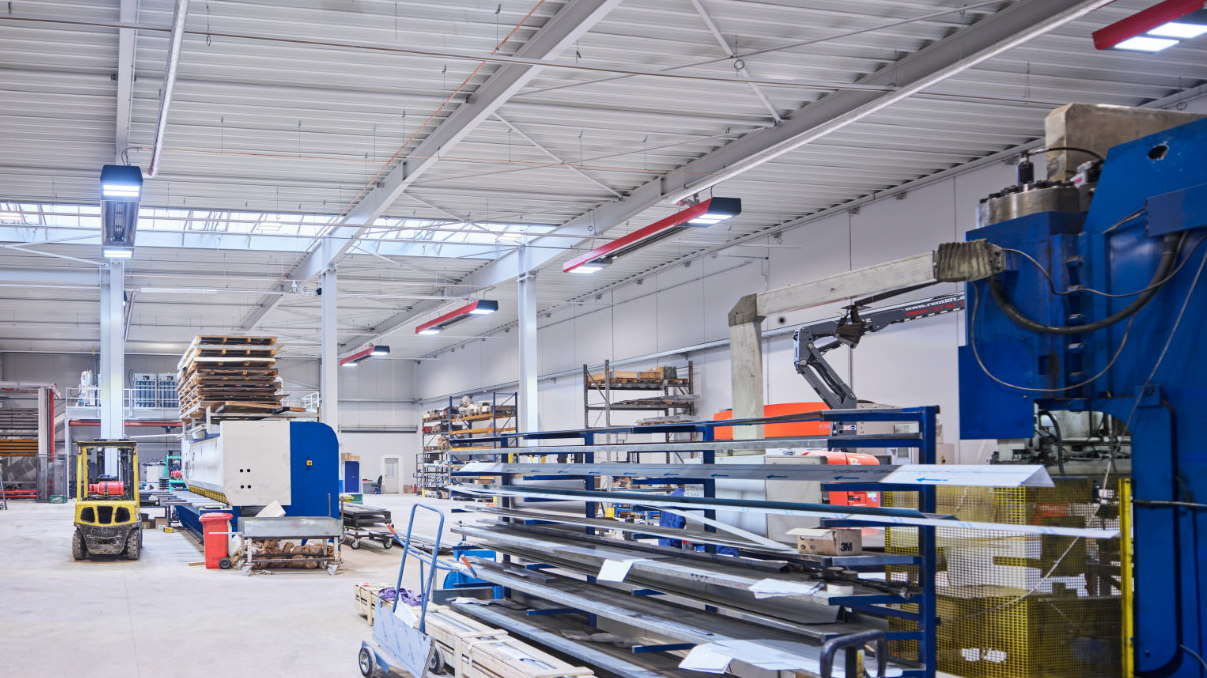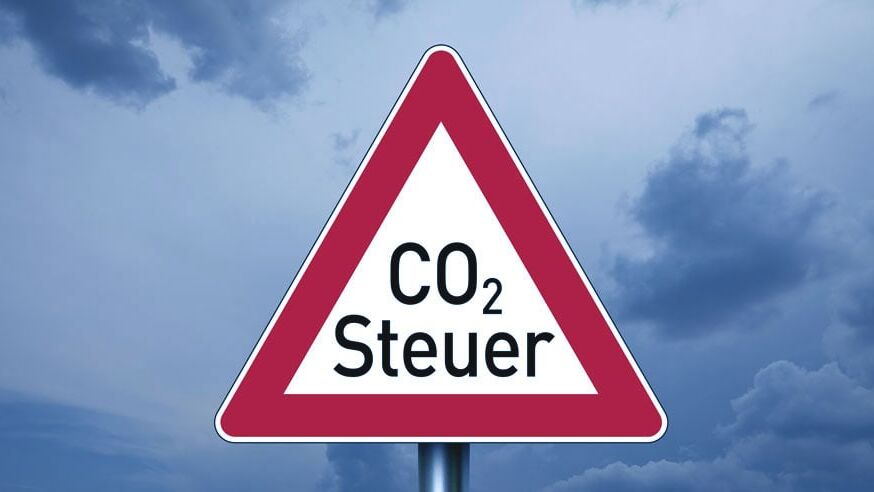The horrendously rising energy prices, the fear of Putin’s supply cut-off, the demand for regenerative energies to combat climate change – all this is currently causing a lot of uncertainty. Is it still worth investing in gas-fired industrial heating at all? The answer to this question is important. Because it will help determine how quickly trade and industry will make their contribution to the energy transition. And how well they will succeed in meeting the future requirement of climate protection in an economically reasonable way.
The misunderstanding starts with the difference between residential and industrial buildings
The uncertainty is great. Is it worth investing in gas-fired hall heating systems at all? Doubts are also fueled by media coverage. Federal Minister of Economics Robert Habeck wants a ban on new gas-fired heating systems, for example, is strikingly reported1). In the process, relevant details are sometimes overlooked. Because the Federal Minister said besides that it concerns with the “from” for gas heatings exclusively new gas heatings for dwelling buildings (with transition period of several years), expressly however not around gas-operated industrial heatings. In production, storage and other hall buildings, infrared radiant heaters with their drastic energy-saving potential are often the only sensible way of heating the enormous volumes of space flexibly, economically and in a CO2-saving manner at comparatively low investment costs.
What options the industry has for action
If one carefully examines the options available to companies, it quickly becomes clear that beyond ideological considerations, there is a clear picture when it comes to hall heating. Whether gas, electricity, oil or hydrogen: all energy sources are expensive. The highest costs are for electricity. This is exacerbated by the fact that availability is limited in some cases. This is especially true for hydrogen. Experts estimate that it will take about two decades before the green gas can completely replace fossil methane.
What facts ensure an economic decision
Business management issues are of great importance when looking for the right industrial heating system. This is because all commercial enterprises are committed to making a profit. Industrial heating systems are long-term investments whose operating costs exceed those of the investment over the life cycle by a factor of six to 20 even before the energy cost explosion. A sustainable as well as economically reasonable decision for one or another heating technology is therefore always based on the following questions:
- How do the total costs (consumption, energy, investment) differ?
- How flexible are the systems in terms of
- Control,
- adjustments, e.g. in the event of changes in hall use,
- Possibility of using different energy sources (also regenerative)?
- How exactly does the heating system fit the hall usage profile?
When answering these questions, it is better not to be guided by speculation. Because what the industry needs are reliable economic framework conditions and resilient facts.
Why halls need special heating systems
Halls are a building category in themselves. They are fundamentally different from other buildings due to their high ceilings, room size and changing usage profiles. The categorization by building type would therefore have to be as follows:
- Residential Buildings (= Storey Buildings),
- Non-residential buildings in multi-story construction (e.g. office buildings, clinics, kindergartens),
- Non-residential buildings in non-story construction with room heights > four meters (= hall buildings).
This distinction is relevant for the selection of the right heating technology and energy source for halls. Storey buildings such as residential and office buildings, kindergartens or hospitals with clear heights of around 2.50 meters can be heated relatively easily. Halls with ceiling heights of four to 40 meters and several hundred or even thousand square meters of floor space, on the other hand, are a real challenge in terms of heating technology, if only for reasons of building physics. If you want to heat these buildings in a functional, economical and ecologically sensible way, you use heating types specially developed for halls.
Among the most efficient are modern industrial heaters such as infrared dark radiators that run on natural gas, liquid gas or biogas. However, these modern high-efficiency technologies have nothing in common with gas heaters used in homes or offices.
How much CO2 reduction potential there is in industrial heating systems
Two percent of all buildings in Germany account for 15 percent of building-related energy and the associated greenhouse gas emissions. It is therefore worth taking a closer look at industrial buildings. After all, they play a very important role in the success of the energy transition. The focus here is on upgrading the energy efficiency of existing halls to the current level of new buildings. The potential savings that can be achieved in this area are estimated in the GAEEH study2) at 59 to 89 billion kilowatt hours per year, or around 6 to 14 percent of the total annual energy consumption for space heating. The savings potential is divided roughly 1:1 between system-related and building-related measures. In one fell swoop, around half of the potential could be tapped through (relatively inexpensive) plant modernization alone – around 38 billion kWh of energy savings p.a. (mean value). This is the equivalent of around eight million metric tons of the greenhouse gas CO2 per year. The technologies with which these savings can be achieved have long been available and can be implemented relatively easily and cost-effectively.
Which heating systems the industry (doesn’t) need
Heat pumps are currently in vogue in private households and other multi-story buildings. In the industrial buildings sector, however, their use makes less functional and economic sense due to their low flexibility and relatively high investment and operating costs. In these buildings, decentralized, gas-powered industrial heaters such as infrared dark radiators mark the state of the art. These heaters are modern high-efficiency systems and are considered the golden standard in industrial, commercial and municipal hall buildings – economically and ecologically. There are several reasons for this: these industrial heaters
- sustainably reduce energy consumption by 30 – 70 percent3)
- offer fast payback and high environmental benefits
- respond quickly and precisely to changing heating requirements
- can be flexibly adapted to changes in use
- can be operated variably with methane, green hydrogen and/or biogas
- create a pleasant, uniform, draft-free working climate
- can be expanded with condensing boiler technology to hybrid systems and even to digital hall heating systems
- are often the only sensible solution for existing buildings
How skyrocketing energy costs can be contained
The savings potential offered by decentralized infrared dark radiators in the industrial heating sector is between 30 and 70 percent. They represent a very effective lever for reducing rising energy costs. The record holder in the savings discipline includes digitized infrared dark radiators, ideally in combination with condensing boiler technology (hybrid system). These systems are specifically designed for the particular room dimensions and conditions of use of halls. They can be implemented very simply, very economically and quickly. The practical example of a mechanical engineering company in North Rhine-Westphalia4) shows how interesting this technology is for industrial and commercial enterprises. There, the energy costs for heating the approximately 6,300 square meter hall area could be reduced by around 65 percent: from 71,500 euros annually to 25,000 euros. Based on current energy prices, this would mean a cost reduction from around 170,000 euros to around 83,300 euros – a saving of around 86,700 euros5).
Liquid, bio or green – modern industrial heaters can use any gas.
Decentrally operated infrared dark radiators have long been able to run on regenerative sources such as biogas. The new generations can also run on hydrogen. Green gas makes it possible to transform the economy in a climate-friendly way and at the same time strengthen Germany as a technology location. As the “engine of the energy turnaround,” H2 is seen worldwide as a central building block for decarbonizing the economy and thus for achieving the Paris climate protection targets. Green hydrogen is seen as the only way to make certain industrial processes climate-friendly. Germany benefits from its excellently developed gas supply network and has set itself ambitious targets as part of its National Hydrogen Strategy. By 2050, hydrogen is to be produced from 100 percent renewable energies6).
However, it is clear that the conversion process will not happen overnight. It will take some time before green gas is available in such large quantities that industrial demand can be fully met. Even in the transition period, heating technologies such as infrared dark radiators play an essential role. They can utilize hydrogen admixtures with variable proportions and thus compensate for the volatile availability of both energy sources. These technologies are already available today, for example the efficiency technology infrared hall heaters from KÜBLER.
How Germany secures its gas supply
Why gas is the only alternative for industry
Germany is the fourth largest industrial location in the world after the USA, China and Japan. Natural gas is by far the most important industrial energy source, accounting for a good 31 percent. More than seven million jobs in Germany depend on its availability – and with over 30 percent of the gross national product, a very significant part of our prosperity7).
Gas cannot be replaced in the short term without paralyzing important production processes, losing many jobs, endangering international competitiveness and risking social security in the country. There is no alternative to natural gas for the industry in the long term. Politicians from all parties and countries agree on this.
How Germany secures its gas supply
Gas, a versatile and flexible energy source, is not only important for Germany as an industrial location. The high efficiency of gas applications and the outstandingly well-developed infrastructure also make this low-carbon energy source a valuable commodity. For this reason, efforts are being made at full speed to secure the gas supply in Germany. From the political side, work is being done in several directions:
- Promote energy efficiency, i.e., use as little energy as possible,
- Increase LNG availability,
- Fill gas storage facilities,
- Accelerate green gas.
These measures pay into three important BWMK goals at once. Politicians want to make Germany independent of Russian energy supplies as quickly as possible. At the same time, jobs and the international competitiveness of our technology location are to remain secure. And thirdly, the decarbonization of the economy is to be driven forward in order to achieve the Paris climate targets.
Significant progress on the road to independence
There has now been significant progress on the path to a broader basis for energy supply in Germany. Dependence on Russian gas and oil has fallen by around 20 percent compared with the previous year. In the case of oil from around 35 to now 12 percent, and in the case of gas from previously around 55 to only 35 percent. Coal imports have been reduced even more drastically by the import ban, from 50 percent previously to 8 percent now8).
How liquefied natural gas offers great security of supply
Across Europe, the planning and realization of new LNG terminals is booming – onshore and offshore. Countries such as France, Italy and Spain are way ahead of us. In addition to smaller facilities, 29 plants with relevant capacities are currently in operation in Europe9). Now Germany is following suit in record time. In early May, the pile was driven for the first floating LNG terminal in Wilhelmshaven. Germany’s “declaration of independence” from Putin’s gas is being built in record time and is expected to be operational as early as the end of 2022. Step by step – pushed by the LNG Acceleration Act passed on May 20 – other terminals will follow, for example in Stade and Brunsbüttel.
LNG has so far been fed into the European pipeline network at the terminals from Belgium and the Netherlands and piped to Germany. LNG (liquefied natural gas) is natural gas that is liquefied at temperatures around -162 °C and then requires only a fraction of its original volume (1:600). With the great advantage that liquefied natural gas can be purchased in virtually any market in the world and transported by ship. LNG is the energy carrier that offers great security of supply in the transitional period until large-scale use of renewable energies.
How gas storage facilities are filled
As far as security of gas supply is concerned, several adjustments are being made, including the filling level of German gas storage facilities. They are currently being filled step by step – to at least 80 percent by October 1, and to 90 percent by November 1. This would then correspond to an output of 229.5 terawatt hours – enough to cover about a quarter of annual gas consumption and to get us through the winter well, even if Russia were to turn off the gas tap.
Practical tips: What experts advise now
Practical tip 1: Leverage price increases for heating energy quickly and effectively
Energy prices have risen to new dimensions in recent months. A megawatt hour (MWh) cost in May at the Dutch stock exchange TTF approximately ten to 20 times as much as one year ago10). To cushion these enormous price increases well next winter, experts recommend:
- Learning to understand hall buildings in terms of heating technology, with the aim of using all possible levers to make savings
- reduce energy consumption as quickly as possible
- to use economical and future-proof technologies
- to plan for regenerative energies.
Practical tip 2: Exploit efficiency potential as quickly as possible
Due to their size and high ceilings, hall buildings consume far more energy than, for example, office buildings or other multi-story buildings when they need to be warm in winter. Often, however, far too much energy is burned up. The reasons for this:
- outdated or insufficiently efficient plant technology,
- inaccurate control,
- the heating does not match the usage profile of the hall,
- other important savings potentials such as residual heat are overlooked.
On the other hand, special decentralized industrial heating systems with gaseous energy sources developed for use in hall buildings often offer impressive savings of 30 – 70 percent. These can be realized quickly, cost-effectively and economically.
Practical tip 3: Don’t heat according to the weather
Industrial heaters such as infrared dark radiators can be adapted very flexibly to different usage requirements, regardless of whether they are powered by fossil fuels or renewables. They thus meet another important requirement of industry, which may need to adapt its processes spontaneously to dynamic market demands. Infrared dark radiators have fast heat-up times. This means that additional shifts can be run at short notice if necessary. In addition, individual hall zones can be controlled individually – heating is only provided in the areas where work is being carried out.
Flexibility is one of the important points in which gas-operated hall heating systems differ from hot-water-based technologies (for example, heat pumps). Heat pumps are useful in residential or office applications. These hot-water-based systems can hardly meet the dynamic requirements of industry due to their inertia. In addition, they require an enormous amount of space either under the hall ceiling or in the floor, limiting flexibility here as well. For example, when setting up machines or changing the use of the hall. Once the underfloor heating has been installed, the floor can no longer be drilled into without further ado in order to relocate or reinstall machines.
Practical tip 4: Optimize the operation of your industrial heating system.
The most economical heating system is the one you don’t need. Experts therefore advise:
- Only use systems that offer fast heat-up times and are flexible.
- Heat only where quality heat is really needed for people.
- Lower the temperatures for unfrequented hall areas in good time.
By the way: Intelligent heating control systems with integrated energy management systems (e.g. E.M.M.A. from KÜBLER) create transparency about the relevant parameters of your heating process and help to automatically drive the heating operation to the ideal line. Optimized operation of the system alone offers potential savings of up to 20 percent.
References
1) Source: https://www.report-k.de/wirtschaftsminister-habeck-will-verbot-neuer-gasheizungen/
2) The study “Overall Analysis of Energy Efficiency of Indoor Buildings” (ITG Institut für Technische Gebäudeausrüstung Dresden and University of Kassel, Department of Building Physics, 2009-2011) is based on the following figures:
- Total energy consumption for space heating in Germany: 625 billion kWh, of which
- Space heating share of residential buildings (18 million): 428 billion kWh,
- Space heating share of indoor buildings (359,000 of 1.5 million non-residential buildings, built 1960 to 2009): 116 billion kWh,
- Space heating share of remaining non-residential buildings (1.14 million): 81 billion kWh,
- Renovation potential of indoor buildings: 64 percent.
The dena Building Report 2022 does not deal separately with hall buildings. However, both the building stock and climate-adjusted heat consumption continued to rise in 2019.
3) Energy-saving hall heating systems from KÜBLER compared to conventional units.
4) Project energetically refurbished with H.Y.B.R.I.D. (dark radiators, condensing technology and digital control from KÜBLER GmbH Energiesparende Hallenheizungen, Ludwigshafen).
5) Calculation basis: Original energy price in the mix gas/oil Ø approx. 0.05 Euro / kWh, current energy price: Ø 0.13 Euro / kWh
6) https://www.pwc.de/de/energiewirtschaft/wasserstoff-ein-essentieller-baustein-der-energiewende/chance-zur-dekarbonisierung-gruener-wasserstoff-als-motor-der-energiewende.html?utm_source=google.com&utm_medium=cpc&utm_campaign=XM_trustintransformation_SV&utm_content=text&utm_term=gr%C3%BCner%20wasserstoff
7) https://www.zdf.de/nachrichten/wirtschaft/gasversorgung-energiesicherheit-deutschland-pipelines-russland-100.html
8) Handelsblatt 01.05.2022, https://www.handelsblatt.com/politik/international/import-deutschland-verringert-energieabhaengigkeit-von-russland/28293452.html
9) Source: Chemietechnik 25.02.2022, https://www.chemietechnik.de/energie-utilities/interaktive-karte-lng-terminals-in-europa-802.html
10) https://www.handelsblatt.com/politik/energiekrise-gaspreis-bricht-alle-rekorde-forderung-nach-preisdeckel/28139228.html
These articles might also interest you
Let's take the next step together
Every hall is different. With more than 30 years of company history, there is hardly a requirement that is unknown to us. Together with our customers, we have implemented the appropriate solutions. If you are ready to implement economically proven heating concepts for your hall, then you have come to the right place.










